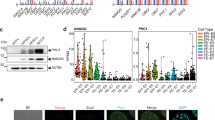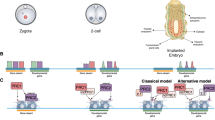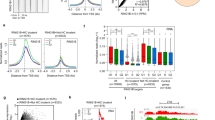Abstract
The mechanisms by which embryonic stem (ES) cells self-renew while maintaining the ability to differentiate into virtually all adult cell types are not well understood. Polycomb group (PcG) proteins are transcriptional repressors that help to maintain cellular identity during metazoan development by epigenetic modification of chromatin structure1. PcG proteins have essential roles in early embryonic development2,3,4,5,6 and have been implicated in ES cell pluripotency2, but few of their target genes are known in mammals. Here we show that PcG proteins directly repress a large cohort of developmental regulators in murine ES cells, the expression of which would otherwise promote differentiation. Using genome-wide location analysis in murine ES cells, we found that the Polycomb repressive complexes PRC1 and PRC2 co-occupied 512 genes, many of which encode transcription factors with important roles in development. All of the co-occupied genes contained modified nucleosomes (trimethylated Lys 27 on histone H3). Consistent with a causal role in gene silencing in ES cells, PcG target genes were de-repressed in cells deficient for the PRC2 component Eed, and were preferentially activated on induction of differentiation. Our results indicate that dynamic repression of developmental pathways by Polycomb complexes may be required for maintaining ES cell pluripotency and plasticity during embryonic development.
This is a preview of subscription content, access via your institution
Access options
Subscribe to this journal
Receive 51 print issues and online access
$199.00 per year
only $3.90 per issue
Buy this article
- Purchase on SpringerLink
- Instant access to full article PDF
Prices may be subject to local taxes which are calculated during checkout



Similar content being viewed by others
References
Ringrose, L. & Paro, R. Epigenetic regulation of cellular memory by the Polycomb and Trithorax group proteins. Annu. Rev. Genet. 38, 413–443 (2004)
O'Carroll, D. et al. The Polycomb-group gene Ezh2 is required for early mouse development. Mol. Cell. Biol. 21, 4330–4336 (2001)
Pasini, D., Bracken, A. P., Jensen, M. R., Lazzerini Denchi, E. & Helin, K. Suz12 is essential for mouse development and for EZH2 histone methyltransferase activity. EMBO J. 23, 4061–4071 (2004)
Shumacher, A., Faust, C. & Magnuson, T. Positional cloning of a global regulator of anterior–posterior patterning in mice. Nature 383, 250–253 (1996)
Voncken, J. W. et al. Rnf2 (Ring1b) deficiency causes gastrulation arrest and cell cycle inhibition. Proc. Natl Acad. Sci. USA 100, 2468–2473 (2003)
Isono, K. et al. Mammalian polyhomeotic homologues Phc2 and Phc1 act in synergy to mediate polycomb repression of Hox genes. Mol. Cell. Biol. 25, 6694–6706 (2005)
Boyer, L. A. et al. Core transcriptional regulatory circuitry in human embryonic stem cells. Cell 122, 947–956 (2005)
Cao, R. et al. Role of histone H3 lysine 27 methylation in Polycomb-group silencing. Science 298, 1039–1043 (2002)
Czermin, B. et al. Drosophila enhancer of Zeste/ESC complexes have a histone H3 methyltransferase activity that marks chromosomal Polycomb sites. Cell 111, 185–196 (2002)
Kuzmichev, A., Nishioka, K., Erdjument-Bromage, H., Tempst, P. & Reinberg, D. Histone methyltransferase activity associated with a human multiprotein complex containing the Enhancer of Zeste protein. Genes Dev. 16, 2893–2905 (2002)
Muller, J. et al. Histone methyltransferase activity of a Drosophila Polycomb group repressor complex. Cell 111, 197–208 (2002)
Kirmizis, A. et al. Silencing of human polycomb target genes is associated with methylation of histone H3 Lys 27. Genes Dev. 18, 1592–1605 (2004)
Hombria, J. C. & Lovegrove, B. Beyond homeosis—HOX function in morphogenesis and organogenesis. Differentiation 71, 461–476 (2003)
Schepers, G. E., Teasdale, R. D. & Koopman, P. Twenty pairs of sox: extent, homology, and nomenclature of the mouse and human sox transcription factor gene families. Dev. Cell 3, 167–170 (2002)
Lehmann, O. J., Sowden, J. C., Carlsson, P., Jordan, T. & Bhattacharya, S. S. Fox's in development and disease. Trends Genet. 19, 339–344 (2003)
Showell, C., Binder, O. & Conlon, F. L. T-box genes in early embryogenesis. Dev. Dyn. 229, 201–218 (2004)
Burch, J. B. Regulation of GATA gene expression during vertebrate development. Semin. Cell Dev. Biol. 16, 71–81 (2005)
Montgomery, N. D. et al. The murine polycomb group protein Eed is required for global histone H3 lysine-27 methylation. Curr. Biol. 15, 942–947 (2005)
Cao, R., Tsukada, Y. & Zhang, Y. Role of Bmi-1 and Ring1A in H2A ubiquitylation and Hox gene silencing. Mol. Cell 20, 845–854 (2005)
Gidekel, S. & Bergman, Y. A unique developmental pattern of Oct-3/4 DNA methylation is controlled by a cis-demodification element. J. Biol. Chem. 277, 34521–34530 (2002)
Hattori, N. et al. Epigenetic control of mouse Oct-4 gene expression in embryonic stem cells and trophoblast stem cells. J. Biol. Chem. 279, 17063–17069 (2004)
Feldman, N. et al. G9a-mediated irreversible epigenetic inactivation of Oct-3/4 during early embryogenesis. Nature Cell Biol. 8, 188–194 (2006)
Vire, E. et al. The Polycomb group protein EZH2 directly controls DNA methylation. Nature 439, 871–874 (2006)
Meissner, A. et al. Reduced representation bisulfite sequencing for comparative high-resolution DNA methylation analysis. Nucleic Acids Res. 33, 5868–5877 (2005)
Li, E., Bestor, T. H. & Jaenisch, R. Targeted mutation of the DNA methyltransferase gene results in embryonic lethality. Cell 69, 915–926 (1992)
Lee, T. et al. Control of developmental regulators by Polycomb in human embryonic stem cells. Cell 125, 1–13 (2006)
Acknowledgements
We thank Biology and Research Computing (BaRC), especially B. Yuan, T. Dicesare and T. Volkert, at the Whitehead Institute's Center for Microarray Technology, as well as E. Herbolsheimer, for computational and technical support. We also thank members of the Gifford, Young and Jaenisch laboratories for discussions and critical review of the manuscript. We are grateful to T. Magnuson for the Eed mutant (17Rn5-3354SB) ES cell lines. L.A.B. was supported in part by an NIH NRSA fellowship. K.P. is a special fellow of the Leukemia and Lymphoma Society. M.W. is supported by a Human Frontiers Science Program Organization Fellowship. M.V. is supported by a grant from the Spanish Ministry of Science and Education. This work was supported in part by grants from the NIHGRI and NIGMS to R.A.Y. and from the NIH and NCI to R.J.
Author information
Authors and Affiliations
Corresponding author
Ethics declarations
Competing interests
T.I.L., D.K.G. and R.A.Y. consult for Agilent Technologies.
Supplementary information
Supplementary Notes
This file contains the Supplementary Methods and Supplementary Discussion; Supplementary Notes; Supplementary Figure Legends 1–9; Supplementary Figures 1–9. (PDF 9721 kb)
Supplementary Table 1
This file contains chromosomal coordinates for genomic regions bound by Suz12. (XLS 102 kb)
Supplementary Table 2
This file contains chromosomal coordinates for genomic regions bound by Eed. (XLS 69 kb)
Supplementary Table 3
This file contains chromosomal coordinates for genomic regions bound by Rnf2. (XLS 91 kb)
Supplementary Table 4
This file contains chromosomal coordinates for genomic regions bound by Phc1. (XLS 69 kb)
Supplementary Table 5
This file contains the assignment of bound genomic regions to annotated transcripts. (XLS 4189 kb)
Supplementary Table 6
This file contains data from the independent site specific validation used to estimate error rates in location analysis data. (XLS 53 kb)
Supplementary Table 7.
This file contains chromosomal coordinates for genomic regions bound by H3K27me3. (XLS 175 kb)
Supplementary Table 8
This file contains all enriched gene ontology classifications for bound genes. (XLS 103 kb)
Supplementary Table 9
This file contains the complete list of transcription factor genes bound by PcG proteins. (DOC 36 kb)
Supplementary Table 10
This file contains all oligo sequences and RT-PCR results in wild-type and eed mutant ES cells used to generate Figure 2 in the main text. (XLS 39 kb)
Supplementary Table 11
This file contains the microarray expression data used to analyse the expression of PcG bound genes in ES cells and during ES cell differentiation as displayed in Figure 3 in the main text. (XLS 6725 kb)
Rights and permissions
About this article
Cite this article
Boyer, L., Plath, K., Zeitlinger, J. et al. Polycomb complexes repress developmental regulators in murine embryonic stem cells. Nature 441, 349–353 (2006). https://doi.org/10.1038/nature04733
Received:
Accepted:
Published:
Issue Date:
DOI: https://doi.org/10.1038/nature04733
This article is cited by
-
Abnormal H3K4 enzyme catalytic activity and neuronal morphology caused by ASH1L mutations in individuals with Tourette syndrome
European Child & Adolescent Psychiatry (2024)
-
Phosphorylation of EZH2 differs HER2-positive breast cancer invasiveness in a site-specific manner
BMC Cancer (2023)
-
Molecular versatility during pluripotency progression
Nature Communications (2023)
-
UHRF1/UBE2L6/UBR4-mediated ubiquitination regulates EZH2 abundance and thereby melanocytic differentiation phenotypes in melanoma
Oncogene (2023)
-
Single-cell sortChIC identifies hierarchical chromatin dynamics during hematopoiesis
Nature Genetics (2023)



